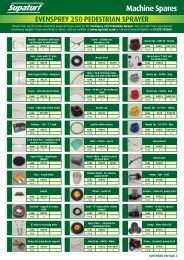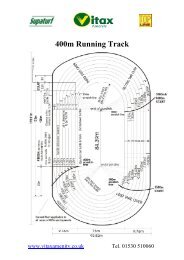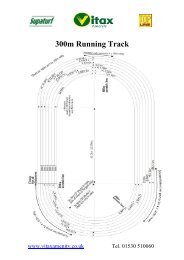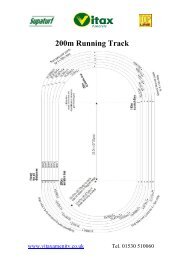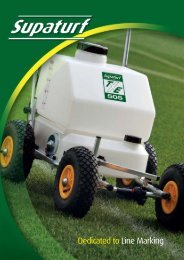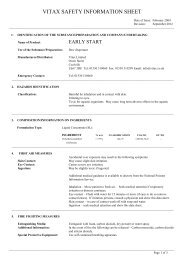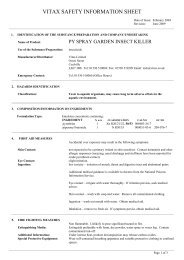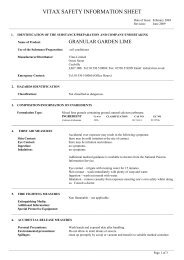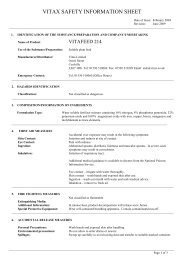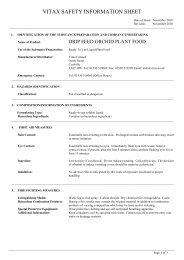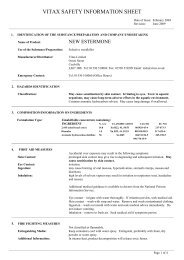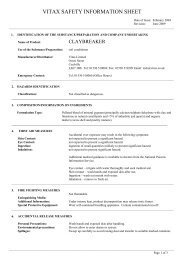Citrus Feed For Winter Use - Vitax
Citrus Feed For Winter Use - Vitax
Citrus Feed For Winter Use - Vitax
You also want an ePaper? Increase the reach of your titles
YUMPU automatically turns print PDFs into web optimized ePapers that Google loves.
VITAX SAFETY INFORMATION SHEET<br />
Date of Issue: February 2004<br />
Revision: June 2009<br />
__________________________________________________________________________________________________________<br />
1. IDENTIFICATION OF THE SUBSTANCE/PREPARATION AND COMPANY/UNDERTAKING<br />
Name of Product: CITRUS FEED FOR WINTER USE<br />
<strong>Use</strong> of the Substance/Preparation: Plant fertiliser<br />
Manufacturer/Distributor: <strong>Vitax</strong> Limited<br />
Owen Street<br />
Coalville<br />
LE67 3DE Tel: 01530 510060 Fax: 01530 510299 Email: tech@vitax.co.uk<br />
Emergency Contact: Tel: 01530 510060 (Office Hours)<br />
________________________________________________________________________________________________________<br />
2. HAZARDS IDENTIFICATION<br />
Classification: Not classified as dangerous.<br />
________________________________________________________________________________________________________<br />
3. COMPOSITION/INFORMATION ON INGREDIENTS<br />
<strong>For</strong>mulation Type: Water soluble fertiliser mixture containing 20% nitrogen, 20% phosphorus pentoxide,<br />
20% potassium oxide with iron, copper and manganese as trace elements.<br />
____________________________________________________________________________________________________<br />
4. FIRST AID MEASURES<br />
Skin Contact:<br />
Accidental over exposure may result in the following symptoms:<br />
Irritation and redness at site of contact.<br />
Eye Contact: Pain and redness.<br />
Ingestion: Abdominal spasms, diarrhoea, faintness and muscular spasms. In sever cases<br />
symptoms may result in convulsions.<br />
Inhalation: Irritation of respiratory tract.<br />
Additional medical guidance is available to doctors from the National Poisons<br />
Information Service.<br />
Eye contact – irrigate with water thoroughly.<br />
Skin Contact – wash hands and exposed skin after use.<br />
Ingestion – wash out mouth with water and seek medical advice.<br />
Inhalation – remove to fresh air.<br />
________________________________________________________________________________________________________<br />
5. FIRE FIGHTING MEASURES<br />
Not classified as flammable.<br />
Extinguishing Media: Contain contaminated run-off.<br />
Additional Information: In intense heat, product decomposition may release toxic fumes.<br />
Special Protective Equipment: Wear self-contained breathing apparatus. Contain contaminated run-off.<br />
________________________________________________________________________________________________________<br />
6. ACCIDENTAL RELEASE MEASURES<br />
Personal Precautions: Wash hands and exposed skin after handling.<br />
Environmental precautions: Do not allow to enter drains or sewers.<br />
Spillages: Sweep up gently to avoid raising dust and transfer to suitable container.<br />
__________________________________________________________________________________________________________<br />
Page 1 of 3
VITAX SAFETY INFORMATION SHEET<br />
Date of Issue: February 2004<br />
Revision: June 2009<br />
__________________________________________________________________________________________________________<br />
7. HANDLING & STORAGE<br />
Handling: Do not block stack pallets.<br />
Storage: Store in original containers, tightly closed in a secure, well ventilated, cool but frostfree,<br />
dry area away from combustible materials. Store clear of foodstuffs and in a<br />
separate stack from herbicides.<br />
_________________________________________________________________________________________________________<br />
8. EXPOSURE CONTROLS/ No specific personal protective equipment assigned. Normal good industrial hygiene<br />
PERSONAL PROTECTION practices should be observed.<br />
_______________________________________________________________________________________________________<br />
9. PHYSICAL & CHEMICAL Appearance pink powder<br />
PROPERTIES Odour none<br />
pH not applicable<br />
Boiling point decomposes above 130 deg C<br />
Melting point not available<br />
Flash point N/A<br />
Flammability N/A<br />
Autoflammability N/A<br />
Explosivity N/A<br />
Oxidising properties N/A<br />
Vapour pressure N/A<br />
Relative density N/A<br />
Solubility very soluble<br />
Other data none<br />
_____________________________________________________________________________________________________<br />
10. STABILITY & REACTIVITY<br />
Stability:<br />
Conditions to Avoid: avoid high temperatures<br />
Materials to Avoid:<br />
Hazardous Decomposition Products: decomposes at high temperatures producing ammonia isocyanic acid and nitrogen<br />
oxide fumes.<br />
________________________________________________________________________________________________________<br />
11. TOXICOLOGICAL Not classified as harmful by inhalation, ingestion or in contact with skin. Ingestion<br />
INFORMATION of large quantities may cause gastric disturbance. Dust may irritate eyes, nose and<br />
respiratory tract.<br />
To the best of our knowledge physical, chemical and toxicological properties have<br />
not been fully investigated.<br />
_____________________________________________________________________________________________________<br />
12. ECOLOGICAL INFORMATION Provides nutrients essential to plant growth. Can cause nitrate contamination of<br />
ground waters if used indiscriminately. Do not exceed recommended application<br />
rates.<br />
_______________________________________________________________________________________________________<br />
13. DISPOSAL CONSIDERATIONS Disposal route should not permit nitrate contamination of groundwater.<br />
Dispose of waste through a reputable waste disposal contractor and in accordance<br />
with the Environmental Protection Act 1990.<br />
__________________________________________________________________________________________________________<br />
Page 2 of 3
VITAX SAFETY INFORMATION SHEET<br />
Date of Issue: February 2004<br />
Revision: June 2009<br />
__________________________________________________________________________________________________________<br />
14. TRANSPORT INFORMATION Not classified as dangerous for carriage.<br />
________________________________________________________________________________________________________<br />
15. REGULATORY INFORMATION Not classified as dangerous for supply.<br />
Occupational Exposure Standards: <strong>For</strong> nuisance dusts: total inhalable 10 mg/m 3 (8<br />
hr), total respirable 5 mg/m 3 (8 hr).<br />
________________________________________________________________________________________________________<br />
16. OTHER INFORMATION This product label provides information on the use of the product: do not use<br />
otherwise, unless you have assessed any potential hazard involved, the safety<br />
measures required.<br />
Prepared by VITAX LTD, for Health and Safety purposes from the best knowledge<br />
available at the time of printing.<br />
The classification of this preparation was carried out in accordance with directive<br />
1999/45/EC and subsequent amendments modified by directive 2006/08/EC, taking<br />
account the directive 67/548/EC (Dangerous substances) modified by directive<br />
2004/73/EC and Regulation (EC) 1907/2006 (REACH).<br />
__________________________________________________________________________________________________________<br />
Page 3 of 3



